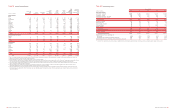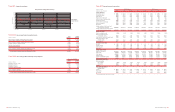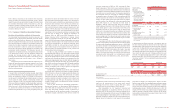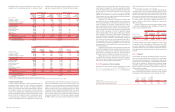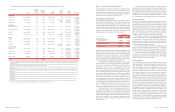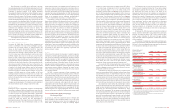Bank of America 2003 Annual Report Download - page 43
Download and view the complete annual report
Please find page 43 of the 2003 Bank of America annual report below. You can navigate through the pages in the report by either clicking on the pages listed below, or by using the keyword search tool below to find specific information within the annual report.
above, includes the imprecision inherent in the forecasting method-
ologies, as well as domestic and global economic uncertainty.
Management assesses each of these components to determine the
overall level of the general portion. The relationship of the general
component to the total allowance for loan and lease losses may fluc-
tuate from period to period. Management evaluates the adequacy of
the allowance for loan and lease losses based on the combined total
of specific, formula and general components.
The process of extending credit through unfunded lending com-
mitments also exposes the Corporation to credit risk. We use a
process to determine credit exposure in our portfolio of unfunded
lending commitments similar to the one described above for the
loans and leases portfolio.
Allowance for credit losses related to the lending portfolio and
unfunded lending commitments are reported on the Consolidated
Balance Sheet in the allowance for loan and lease losses, and
accrued expenses and other liabilities, respectively. Provision for
credit losses related to the loans and leases portfolio and unfunded
lending commitments are both reported in the Consolidated
Statement of Income in the provision for credit losses.
Nonperforming Loans
Commercial loans and leases that are past due 90 days or more as
to principal or interest, or where reasonable doubt exists as to timely
collection, including loans that are individually identified as being
impaired, are generally classified as nonperforming loans unless well-
secured and in the process of collection. Loans whose contractual
terms have been restructured in a manner which grants a concession
to a borrower experiencing financial difficulties, without compensa-
tion on restructured loans, are classified as nonperforming until the
loan is performing for an adequate period of time under the restruc-
tured agreement. In situations where the Corporation does not
receive adequate compensation, the restructuring is considered a
troubled debt restructuring. Interest accrued but not collected is
reversed when a commercial loan is classified as nonperforming.
Interest collections on commercial nonperforming loans and leases
for which the ultimate collectibility of principal is uncertain are
applied as principal reductions; otherwise, such collections are cred-
ited to income when received.
Credit card loans are charged off at 180 days past due or 60
days from notification of bankruptcy filing and are not classified as
nonperforming. Unsecured consumer loans and deficiencies in non-
real estate secured loans are charged off at 120 days past due and
not classified as nonperforming. Real estate secured consumer
loans are placed on nonaccrual and classified as nonperforming at
90 days past due. The amount deemed uncollectible on real estate
secured loans is charged off at 180 days past due.
Loans Held for Sale
Loans held for sale include residential mortgage, loan syndications,
and to a lesser degree commercial real estate, consumer finance and
other loans, and are carried at the lower of aggregate cost or market
value. Loans held for sale are included in other assets.
Premises and Equipment
Premises and equipment are stated at cost less accumulated depre-
ciation and amortization. Depreciation and amortization are recog-
nized using the straight-line method over the estimated useful lives
of the assets. Estimated lives range up to 40 years for buildings, up
to 12 years for furniture and equipment and the shorter of lease term
or estimated useful life for leasehold improvements.
Mortgage Banking Assets
The mortgage servicing rights (MSRs) and Excess Spread Certificates
(the Certificates) generated by the Corporation’s Mortgage Selling and
Servicing Contracts are classified as mortgage banking assets (MBAs)
on the Consolidated Balance Sheet. The MSR component represents
the contractually specified servicing fees and, in certain instances,
float on escrow balances, net of the Corporation’s cost to service, and
the Certificates represent a retained financial interest in certain cash
flows of the underlying mortgage loans. The MSRs are accounted for
on a lower-of-cost or market basis. The Certificates are carried at esti-
mated fair value with the mark-to-market adjustment reported in
trading account profits. The Corporation seeks to manage changes in
value of the MSR and the Certificates due to changes in prepayment
rates by entering into derivative financial instruments such as pur-
chased options and interest rate swaps. The derivative instruments
are carried at estimated fair value with the corresponding adjustment
reported in trading account profits. The Corporation values the
Certificates using an option-adjusted spread model which requires
several key components including, but not limited to, proprietary pre-
payment models and term structure modeling via Monte Carlo simu-
lation. The fair value of the Certificates was $2.3 billion and $1.6
billion at December 31, 2003 and 2002, respectively. The carrying
value of the MSRs was $466 million and $492 million at December
31, 2003 and 2002, respectively. Total loans serviced were $246.5
billion and $264.5 billion at December 31, 2003 and 2002 respec-
tively, including loans serviced on behalf of the Corporation’s banking
subsidiaries.
The Corporation allocated the total cost of mortgage loans orig-
inated for sale or purchased between the cost of the loans, and when
applicable, the Certificates and the MSRs based on the relative fair
values of the loans, the Certificates and the MSRs. MSRs acquired
separately are capitalized at cost. The Corporation recorded $1.6 bil-
lion and $884 million of MBAs during 2003 and 2002, respectively.
The cost of MSRs was amortized in proportion to and over the esti-
mated period that servicing revenues were recognized.
Mortgage banking income includes certificate and servicing
fees, ancillary servicing income, mortgage production fees, and gains
and losses on sales of loans to the secondary market.
Goodwill and Other Intangibles
Net assets of companies acquired in purchase transactions are
recorded at fair value at the date of acquisition, as such, the histori-
cal cost basis of individual assets and liabilities are adjusted to reflect
their fair value. Identified intangibles are amortized on an accelerated
or straight-line basis over the period benefited. Goodwill is not amor-
tized but is reviewed for potential impairment on an annual basis, or
if events or circumstances indicate a potential impairment, at the
reporting unit level. The impairment test is performed in two phases.
The first step of the goodwill impairment test compares the fair value
of the reporting unit with its carrying amount, including goodwill. If the
fair value of the reporting unit exceeds its carrying amount, goodwill of
the reporting unit is considered not impaired; however, if the carrying
amount of the reporting unit exceeds its fair value, an additional pro-
cedure must be performed. That additional procedure compares the
implied fair value of the reporting unit’s goodwill (as defined in SFAS
No. 142, “Goodwill and Other Intangible Assets” (SFAS 142)) with the
carrying amount of that goodwill. An impairment loss is recorded to
the extent that the carrying amount of goodwill exceeds its implied fair
value. In 2003 and 2002, goodwill was tested for impairment and no
impairment charges were recorded.
Other intangible assets are evaluated for impairment if events and
circumstances indicate a possible impairment. Such evaluation of other
intangible assets is based on undiscounted cash flow projections. At
December 31, 2003, intangible assets included on the Consolidated
Balance Sheet consist of core deposit intangibles that are amortized
using an estimated range of anticipated lives of 6 to 20 years.
Special Purpose Financing Entities
In the ordinary course of business, the Corporation supports its cus-
tomers’ financing needs by facilitating the customers’ access to dif-
ferent funding sources, assets and risks. In addition, the Corporation
utilizes certain financing arrangements to meet its balance sheet
management, funding, liquidity, and market or credit risk manage-
ment needs. These financing entities may be in the form of corpora-
tions, partnerships or limited liability companies, or trusts, and are
generally not consolidated on the Corporation’s balance sheet. The
majority of these activities are basic term or revolving securitization
vehicles for credit card or mortgage securitizations. These vehicles
are generally funded through term-amortizing debt structures
designed to be paid off based on the underlying cash flows of the
assets securitized.
Se curitizations
The Corporation securitizes, sells and services interests in residen-
tial mortgage, consumer finance, commercial and credit card loans.
When the Corporation securitizes assets, it may retain interest-only
strips, one or more subordinated tranches and, in some cases, a
cash reserve account, all of which are considered retained interests
in the securitized assets. Gains upon sale of the assets depend, in
part, on the Corporation’s allocation of the previous carrying amount
of the assets to the retained interests. Previous carrying amounts are
allocated in proportion to the relative fair values of the assets sold
and interests retained.
Quoted market prices, if available, are used to obtain fair val-
ues. Generally, quoted market prices for retained interests are not
available; therefore, the Corporation estimates fair values based
upon the present value of the associated expected future cash flows.
This may require management to estimate credit losses, prepayment
speeds, forward yield curves, discount rates and other factors that
impact the value of retained interests. See Note 9 of the consoli-
dated financial statements for further discussion.
The excess cash flows expected to be received over the amor-
tized cost of the retained interest is recognized as interest income
using the effective yield method. If the fair value of the retained inter-
est has declined below its carrying amount and there has been an
adverse change in estimated contractual cash flows of the underlying
assets, then such decline is determined to be other-than-temporary
and the retained interest is written down to fair value with a corre-
sponding adjustment to earnings.
Othe r Spe cial Purpose Financing Entitie s
Other special purpose financing entities are generally funded with
short-term commercial paper and are similarly paid down through the
cash flow or sale of the underlying assets. These financing entities
are usually contractually limited to a narrow range of activities that
facilitate the transfer of or access to various types of assets or finan-
cial instruments and provide the investors in the transaction protec-
tion from creditors of the Corporation in the event of bankruptcy or
receivership of the Corporation. These financing entities are gov-
erned by SFAS No. 140, “Accounting for Transfers and Servicing of
Financial Assets and Extinguishments of Liabilities – a replacement
of FASB Statement No. 125,” (SFAS 140). In certain situations, the
Corporation provides liquidity commitments and/or loss protection
agreements. See Note 13 of the consolidated financial statements
for further discussion.
The Corporation evaluates whether these entities should be
consolidated by applying accounting principles generally accepted
in the United States and interpretations that generally provide that
a financing entity is not consolidated if both the control, and risks
and rewards of the assets in the financing entity are not retained
by the Corporation. In determining whether the financing entity
should be consolidated, the Corporation considers whether the
entity is a qualifying special purpose entity (QSPE) as defined in
SFAS 140. For sales treatment, SFAS 140 requires that the financing
entity be legally isolated, bankruptcy remote and beyond the control
of the seller, which generally applies to securitizations. See Note 9
of the consolidated financial statements for further discussion. For
non-QSPE structures or VIEs, the FASB issued FIN 46 that
addresses identifying VIEs and determining when a company should
include the assets, liabilities, noncontrolling interests and results
of activities of a VIE in its consolidated financial statements. This
guidance applies to certain transactions and requires an assess-
ment of whether sufficient risks and rewards of ownership have
passed based on assessing the voting rights, control of the entity
and the existence of substantive third party equity investment. For
additional information on the consolidation of VIEs, see Recently
Issued Accounting Pronouncements beginning on page 78 and Note
9 of the consolidated financial statements.
Income Taxes
There are two components of income tax expense: current and deferred.
Current income tax expense approximates cash to be paid or refunded
for taxes for the applicable period. Deferred tax assets and liabilities are
recognized due to differences in the basis of assets and liabilities as
measured by tax laws and their basis as reported in the financial state-
ments. Deferred tax expense or benefit is then recognized for the
change in deferred tax liabilities or assets between periods.
Recognition of deferred tax assets is based on management’s
belief that it is more likely than not that the tax benefit associated
with certain temporary differences, tax operating loss carryforwards
and tax credits will be realized. A valuation allowance is recorded for
the amount of the deferred tax items for which it is more likely than
not that realization will not occur.
82 BANK OF AMERICA 2003 BANK OF AMERICA 2003 83



